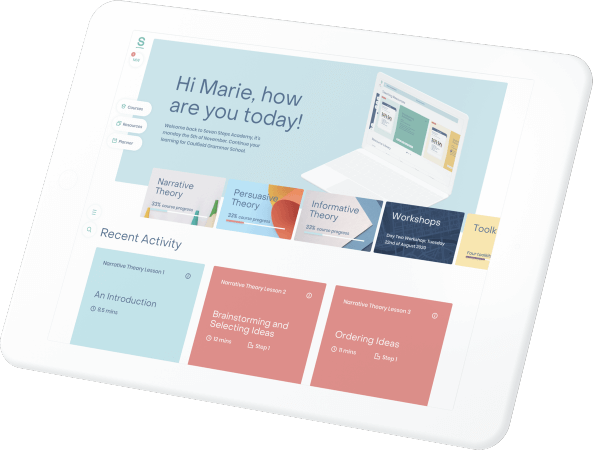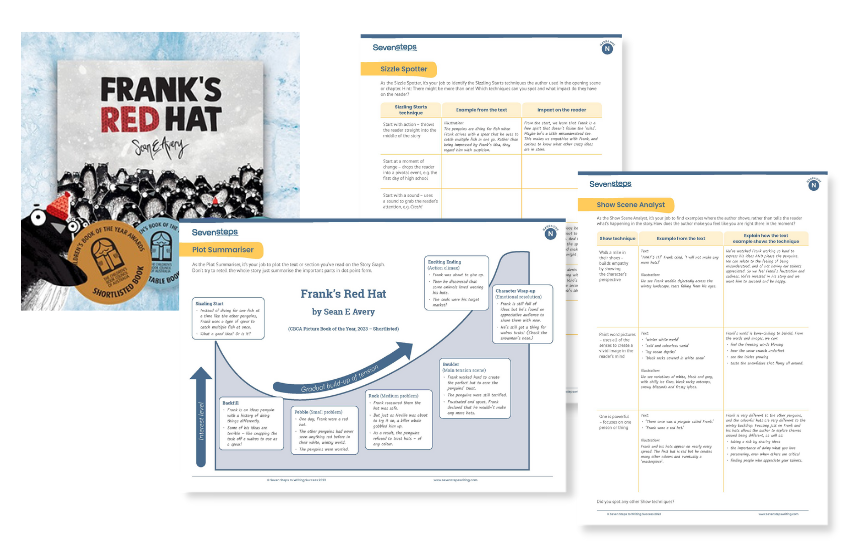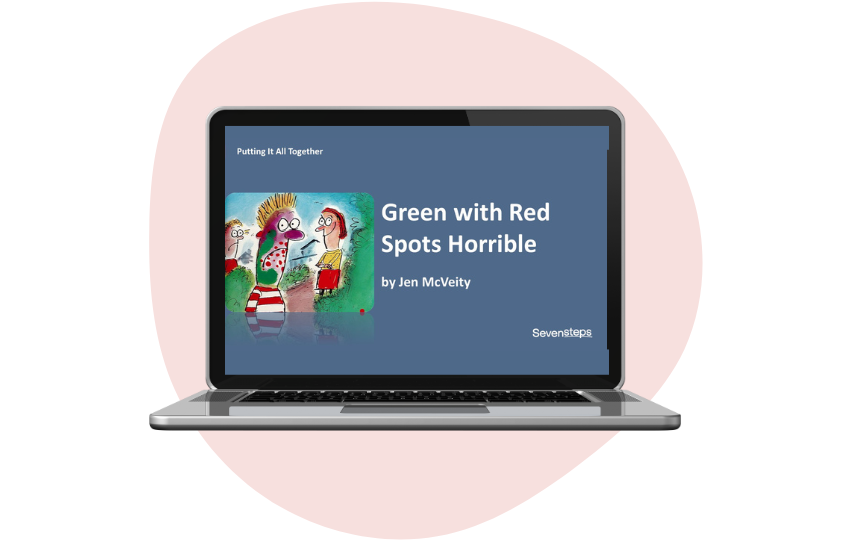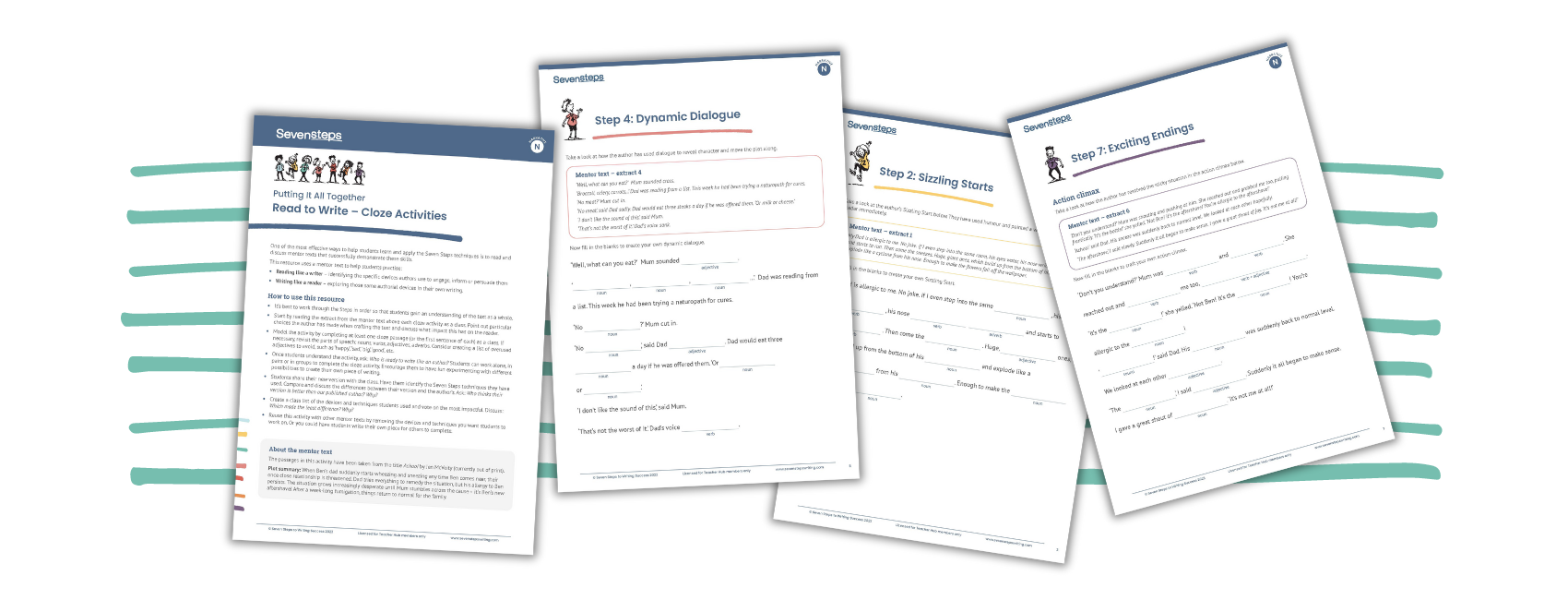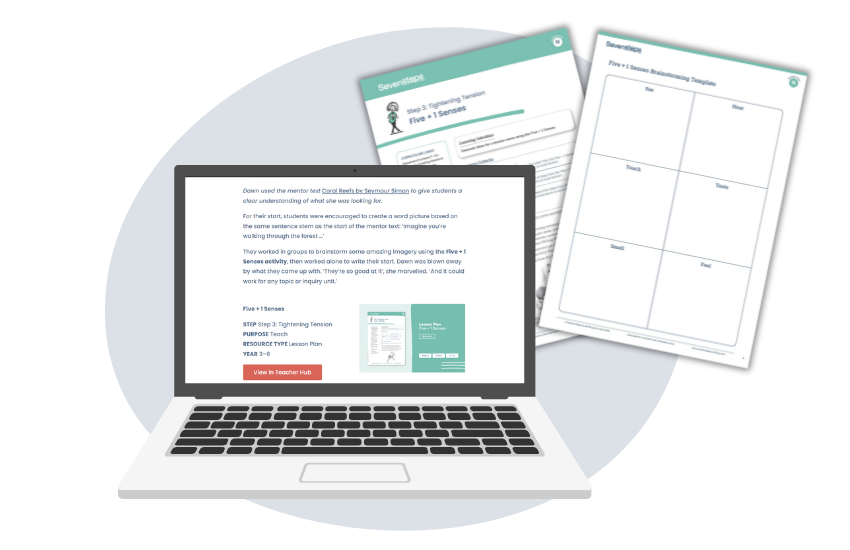No products in the cart.

4 mins

Education

Rebecca Hill
Hands up if you struggle to create explicit links between your reading and writing programs 🙋♀️
A lot of teachers do. Which makes sense, given that educators are well supported in teaching and assessing reading but largely left to wing it when it comes to teaching and assessing writing. (A yawning gap that Seven Steps is here to fill!)
But research shows that there are great benefits for students when reading and writing instruction is integrated across the curriculum. In fact, both the Australian Curriculum and the new NSW syllabus have this at their heart. So, how can you ensure the symbiotic relationship between reading and writing is alive and well in your classroom?
Seven Steps can help you intertwine writing and reading by encouraging students to:
- read like a writer – understand and respond to texts by analysing the techniques authors use, such as vocabulary, text features, language devices, voice and style
- write like a reader – create texts that meet the needs of the reader by applying the techniques professional writers use.
In doing so, Seven Steps makes the reading–writing connection explicit and gives students plenty of opportunities to practise honing these skills.
And the best way to get started is to immerse students in mentor texts.
Using mentor texts
A major part of creating the reading–writing connection is finding the right mentor texts to share with students. The best way to learn is by seeing examples and high-quality mentor texts help students think like an author when they read and write.
A mentor text that demonstrates the techniques in action shows (rather than tells) students what good writing looks like. Picture books and chapter books can work for any year level, as long as students can identify with the book’s themes. But a short passage from a longer text can also work well to cover something specific, such as sensory details.
The units of work created by the NSW Department of Education as part of the new English Syllabus explore mentor texts in order to develop students’ understanding of the techniques professional authors use to shape their texts. Students then experiment with those techniques in their own writing. Take a look at the Seven Steps version of these units on Teacher Hub – they can be used by teachers in any state to foster the reading–writing connection.
To find a range of texts that demonstrate each Step, go to the Resource Library in Teacher Hub and select ‘Text & Video Lists’ in the Resource type dropdown.
Immerse students in a range of mentor texts – magazines, websites, books and newspapers – across genres and encourage them to experiment with and adapt the ideas and techniques in their own writing. Evidence suggests that the more experience students have in reading different genres, the more successful they will be in writing in different genres. Which highlights the importance of learning to ‘read like a writer’.
Reading like a writer
Most students simply read like readers – that is, without noticing the specific devices authors use to engage, inform or persuade them. But this is a missed opportunity for major growth in their writing.
Teach your students to read like writers by giving them explicit instruction on how to identify and analyse the authorial choices the writer has made when they read. This empowers them to mine texts for techniques they can use to supercharge their own writing.
Once students learn to do this, it becomes second nature. Daniela Morsella helped her Year 4 students develop the habit of reading like writers and now they can’t be stopped!
“When we read various texts, my students consistently point out the writing techniques they’ve learned from the Seven Steps. They identify elements such as a Sizzling Start or the use of Show, Don’t Tell in the texts, showcasing their improved understanding of writing and their ability to analyse and appreciate the craft of authors.”
There are lots of great ways to help your students read with a writer’s eye. You could start with a favourite book that students know well and discuss the techniques the author has used and what impact they have on the reader.
Reading circles are a fun way to do this and can work across any year level, subject area and literacy level – from emerging to gifted readers.
You can use our Reading Circles resource to help students analyse how authorial techniques are used in existing texts before experimenting with them in their own writing.

Green with Red Spots Horrible provides another fun way to create the reading–writing connection. This classroom PowerPoint gives students practice identifying the Seven Steps techniques an author has used in a text and assessing the impact they have on the reader.
It consolidates students’ understanding of both the text and the writing techniques. It’s ideal for middle to upper primary but can also be used for lower ability students in early secondary.
Remember, noticing the craft of writing and thinking like an author is a learnt skill. So, give students plenty of practice reading like a writer until it becomes second nature.
To find more resources that help students read like a writers, go to the Resource Library in Teacher Hub and select ‘Read to Write’ in the Resource type dropdown.
Writing like a reader
We write to be read, so we need to give the reader the same rewarding experience that we want for ourselves as readers. This requires a shift in perspective for students when they write – instead of their usual thinking, students need to think (and then write) like a reader. For example, they might visualise their audience as they write or try to put themselves in the reader’s shoes and ask: Does my plot make sense? Is my introduction engaging? Am I convinced by my argument?
This is where the skill of reading like a writer comes into play. Because once students have learnt to identify what works in published texts, they can use those techniques to great effect in their own writing.
Here are a few ways to get students writing like readers:
- As a class, read a mentor text and compare it to a student draft. Revise the student draft together, and then have students repeat the process with their own drafts.
- In pairs, students create a list of takeaways from the mentor text that they could apply to their own writing. They then emulate one or two of the author’s techniques in a paragraph.
- Students create a list or poster of things to avoid based on texts they have read, such as ‘Once upon a time …’ starts. See Action Activity – Ban Boring Beginnings on Teacher Hub.
- Individual students craft a new piece of writing that mimics an authors’ language, techniques, voice and/or structure. For example, can students write a tension-building documentary voice-over in the style of David Attenborough? Try Writing Challenge – The Attenborough Effect on Teacher Hub to find out.
- Using a sentence frame from a text, craft two examples as a class before students have a go themselves. You might even say, ‘Get ready to write like <author’s name>’ to get them excited about imitating the author’s work. Our Cloze Resource (below 👇) is an easy and practical way to get students identifying the authorial techniques in a mentor text (reading like a writer) and then playing around with those techniques in their own writing (writing like a reader).
Encouraging students to mimic an author’s style levelled up the writing in Dawn Veary’s Year 3 classroom. While creating information brochures as part of an inquiry unit on Australian animals, Dawn used a mentor text to show students Sizzling Starts and Exciting Endings techniques they could use in their writing.
For their introductions, students created a word picture based on the same sentence stem as the start of the mentor text. They worked in groups to brainstorm some amazing imagery using the Five + 1 Senses activity, then worked alone to write their start. Dawn was blown away by what they came up with. ‘They’re so good’, she marvelled. ‘And it could work for any topic or inquiry unit.’
Learn more about how Dawn transformed her students’ informative writing in this blog.
Creating a community of readers and writers
Reading and writing instruction should not be disparate pursuits in the classroom. Given the benefits of reading like a writer and writing like a reader, it’s essential that students experience and understand the link between these two language modes.
You can do this simply by encouraging students to look at the texts you use in reading – the words, the style and the devices the authors carefully chose – and use these as a springboard when creating their own texts.
Because when students are immersed in great writing and have been taught to identify the craft authors use, their writing skillset expands and the possibilities for growth in reading and writing are infinite.


